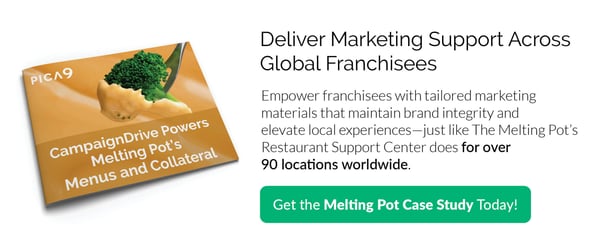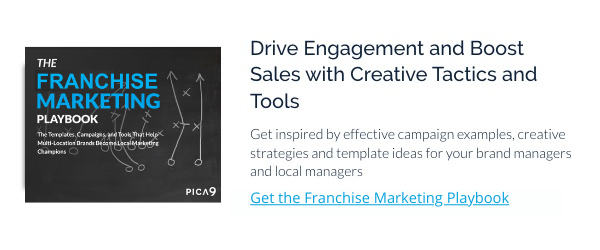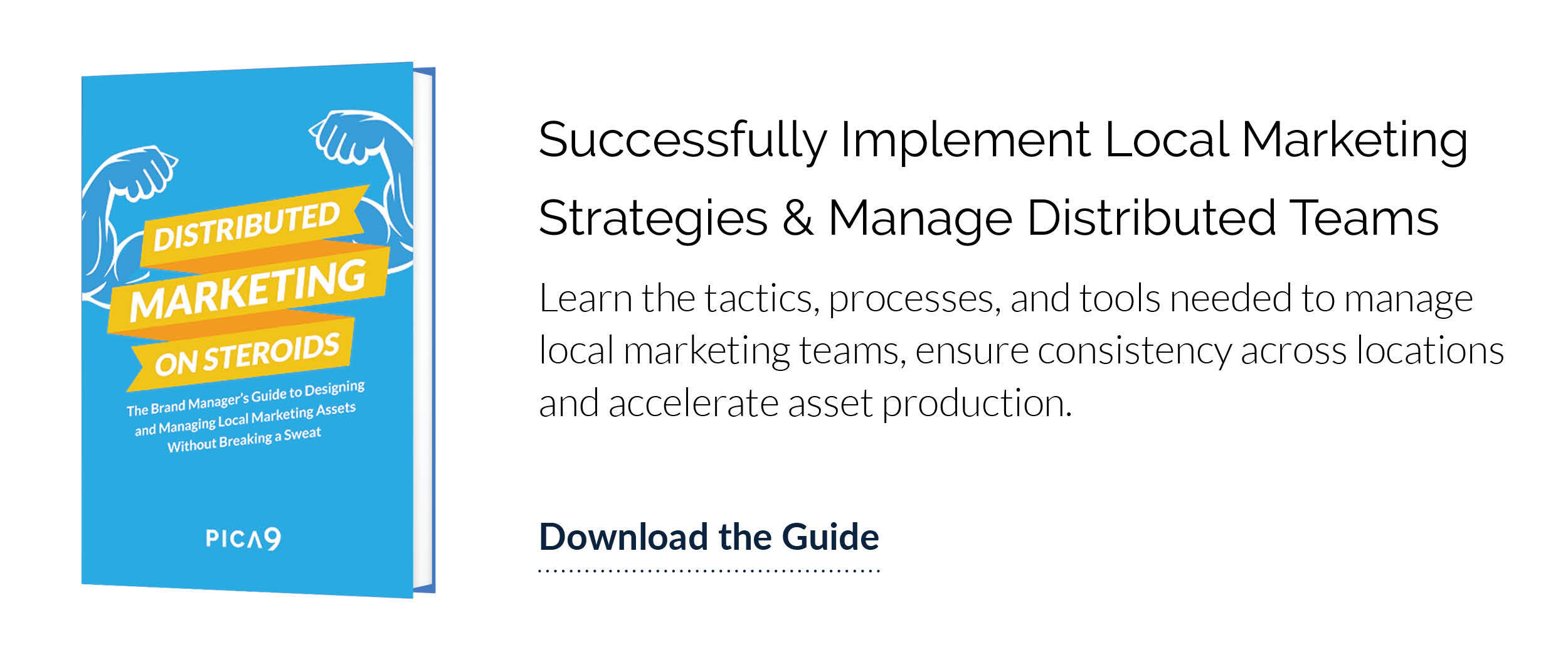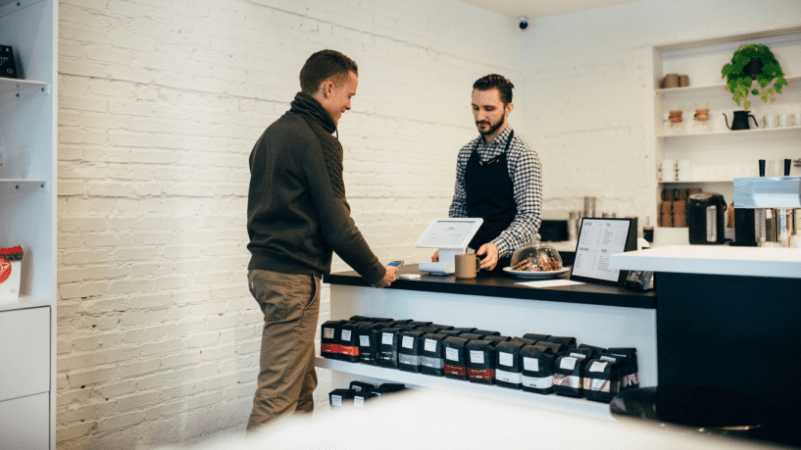Print advertising isn’t going anywhere soon, especially not for restauranteurs. For the $799 billion restaurant industry, print marketing collateral plays an integral role in direct response marketing. Customers know to expect a printed menu at a sit-down restaurant, and branded napkins at fast-and-casual establishments. While digital marketing is becoming an even more important way for restaurants to attract new customers all the time, print still drives restaurants' business every day— both by influencing buying decisions and delivering on the true restaurant experience.
Everyone knows that our choices around food are hugely influenced by the right visuals— like mouthwatering imagery or carefully selected brand colors that send the right appetizing signal. Restaurant brands who unlock the secrets of localized print marketing collateral can take advantage of this consumer psychology and engage their customers, inspire action, increase walk-ins, and improve sales.
Visually-rich print collateral matters to restaurants, as illustrated by the following stats on print response:
- 63 percent of consumers say high-quality images are more important to them than very detailed product descriptions.
- Including an image next to a menu item on restaurant menus increases orders by 30 percent.
- 66 percent of millennial consumers are more likely to remember to use a voucher if they have a physical copy to carry around.
- 23 percent of customers bought or ordered something as a result of receiving direct mail in the last 12 months.
Print marketing collateral is an invaluable tool for franchised restaurant brands. But, brand managers have to overcome some pretty significant barriers to driving local sales with print collateral, including local marketer inexperience with design and the need for localization of print assets.
In this post, we'll share how great restaurant franchises, like The Melting Pot, are developing the methods and capabilities to support better print marketing at each restaurant and drive sales success.
The Need for Localized Print & Problem of Local Inexperience
Brand marketing managers at franchise restaurants are typically supporting marketing across a large, geographically distributed network of restaurant franchisees. One of the key challenges facing these marketers is how to enable local affiliates (often lacking design or marketing skills) to create beautiful, brand compliant assets.
With all of the strategizing and complex work that goes into developing brand campaigns and all the effort that marketers put into launching them the right way— it's little wonder that local restauranteurs are often the weakest link in the chain.
Brand managers aren't alone in recognizing the magnitude of this problem. Eight out of ten CMOs at distributed brands believe that a lack of local marketing expertise is a major barrier to their revenue growth goals.
Paradoxically, at the same time marketers are recognizing that localization in print advertising is critical. Global brands across industries are adopting “glocal” strategies to tailor their advertising, communications, and product offerings to local tastes in each market they operate in. The question is: How can brands provide this degree of localized flavor while still keeping true to the core principles on which they've been built?
Localized Marketing Materials & Restaurant Franchises
Restaurant marketers seem to be between a rock and a hard place when it comes to getting the answer to that question right. Brand management teams haven't got the time to customize print assets for each and every one of their local franchisees. Meanwhile, local restaurant owners generally don’t have the graphic design skills to navigate platforms like the Adobe Creative Cloud and successfully create their own versions of branded assets.
But while good localization in marketing can make a difference for any kind of brand, it's especially important for food and beverage advertisers to get it right. The risks of not having this localization strategy down are major. Without the right process to customize print assets to local needs easily and accurately, F&B brands often face catastrophic brand crisis scenarios.
Even global titans in the restaurant industry can fall victim to the difficulties of implementing on-brand print marketing campaigns across their network of restaurants. Look no further than KFC's challenges with print in the Chinese market for an example of a great brand fighting through the same challenges.
What the Most Effective Restaurant Franchises Do Differently
Delivering a consistently exceptional customer experience (CX) at each of their locations, corporate or franchised, is the primary goal for restaurant brand management teams. These marketers understand that focusing on CX is integral to driving long-term sales, and ultimately, brand growth. Developing a full-coverage print campaign and assets for local execution should be focused on supporting those overall customer experience objectives.
Unified technology is considered critical to local marketing success at distributed brands in 2017. 71 percent of CMOs at multi-location brands surveyed report their local customer experience depends on the consolidation of technologies across both corporate and local marketing initiatives. However, software tools are only one part of the equation for local marketing effectiveness for restaurant franchisees. In fact, it may surprisingly still be. the process, uses, and concepts from great print advertising and collateral that leads to restaurant franchise wins.
For the distributed brands who consistently out-perform revenue targets, a common thread is centralized technologies for local marketing automation (LMA). In fact, industry-leading enterprise brands are 15x more likely than average firms to invest in software-as-a-service (SaaS) based local marketing automation tools. Customizable print templates are the most-desired LMA feature for 96 percent of distributed brands in any industry; defined as features that support franchisees’ need to simply customize and order compliant print materials with templates.
The 3 Keys to Enabling Franchisee Print Marketing Success
From a process standpoint, brand managers who use SaaS LMA tools for local print templates need to consider three distinct phases to be successful: Ideation, Build-out, and Roll-out to the franchisees. When creating print campaigns that really work at the local level, effective build-out and roll-out matter maybe even more than all the hard work that goes into ideating the campaign in the first place. You need your resulting local signs, table toppers, and menus to be top-notch, including compliant, crisp imagery, visuals, and typography.
How can distributed brands ensure print assets are gorgeous, on-brand, and effective? Luckily there are simple keys to remember for each phase.
#1. Ideation
While restaurant franchisees may have a great deal of freedom in customizing menu items to match local tastes, or sending direct mail campaigns to promote local events, print templates are generally conceptualized, designed, and maintained by the brand management team.
When it comes to developing print campaigns with multiple assets or general-purpose assets for franchisees (such as approved menu templates), brand management teams are responsible for brainstorming concepts for print based on-brand assets.
Developing marketing collateral templates that local franchisees are excited to use requires empathy, and an understanding of local restaurant franchisees’ needs. If you've heard time and again that the franchisees are tired of being stuck with content featuring the company mascot, look somewhere else for your inspiration and try to see the campaign through your franchisees' eyes before you go locking the concepts in place.
#2. Build-Out
During the build-out phase, brand management teams will translate campaign and asset concepts into actionable resources for local franchisees. For leading restaurant brands, this involves the build-out of templates, using graphic design resources and LMA tools. Build-out involves effective versioning of ideas by media type and channel, and knowledge of the types of assets that franchisees will use. Every asset that could be used towards achieving coverage for the concept that has already been articulated should be made accessible within the platform's library of assets so that they are easily discovered and used.
To learn what a brand management team’s workflow may look like for transforming marketing assets into franchisee-ready templates in one leading SaaS LMA, CampaignDrive, check out Optimize Internal Workflows with Enterprise Marketing Management.
#3. Roll-Out Phase
Once your campaigns and assets have been translated into easy-to-use templates in your LMA tool, the brand management team is responsible for rolling the materials out to local restaurant franchisees. This requires providing template access and support to local franchisees to encourage timely execution of campaign materials. For evergreen print assets, such as general-purpose direct mail templates, roll-out phases may be an ongoing effort to educate franchisees on best practices for driving business with the latest and greatest print marketing collateral.
Developing the Groundwork for Local Restaurant Print Marketing Results
The right processes and technologies can resolve many of the barriers to delivering exceptional local customer experiences through print marketing. When restaurant franchisees are enabled to create print assets, they are able to provide a more personal approach to key assets like menus, table toppers, and in-store signage.
With the help of a local marketing automation tool, brands can ensure assets are created in a compliant manner, and easily accessed and utilized by locals. SaaS LMA allows brand managers to compensate for restaurant franchisees' marketing inexperience with user-friendly print templates, while meeting the demand for local advertising that is unique for the restaurant business. Everyone — brands, local franchisees, and customers — win when print assets address in-the-moment offers and promotions, and are easily created in a compliant way.








